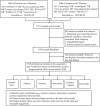A bibliometric analysis of COVID-19 publications in neurology by using the visual mapping method
- PMID: 35958855
- PMCID: PMC9362596
- DOI: 10.3389/fpubh.2022.937008
A bibliometric analysis of COVID-19 publications in neurology by using the visual mapping method
Abstract
Background: The characteristic symptom of coronavirus disease 2019 (COVID-19) is respiratory distress, but neurological symptoms are the most frequent extra-pulmonary symptoms. This study aims to explore the current status and hot topics of neurology-related research on COVID-19 using bibliometric analysis.
Methods: Publications regarding neurology and COVID-19 were retrieved from the Web of Science Core Collection (WoSCC) on March 28 2022. The Advanced search was conducted using "TS = ('COVID 19' or 'Novel Coronavirus 2019' or 'Coronavirus disease 2019' or '2019-nCOV' or 'SARS-CoV-2' or 'coronavirus-2') and TS = ('neurology'or 'neurological' or 'nervous system' or 'neurodegenerative disease' or 'brain' or 'cerebra' or 'nerve')". Microsoft Excel 2010 and VOSviewer were used to characterize the largest contributors, including the authors, journals, institutions, and countries. The hot topics and knowledge network were analyzed by CiteSpace and VOSviewer.
Results: A total of 5,329 publications between 2020 and 2022 were retrieved. The United States, Italy, and the United Kingdom were three key contributors to this field. Harvard Medical School, the Tehran University of Medical Sciences, and the UCL Queen Square Institute of Neurology were the major institutions with the largest publications. Josef Finsterer from the University of São Paulo (Austria) was the most prolific author. Tom Solomon from the University of Liverpool (UK) was the most cited author. Neurological Sciences and Frontiers in Neurology were the first two most productive journals, while Journal of Neurology held the first in terms of total citations and citations per publication. Cerebrovascular diseases, neurodegenerative diseases, encephalitis and encephalopathy, neuroimmune complications, neurological presentation in children, long COVID and mental health, and telemedicine were the central topics regarding the neurology-related research on COVID-19.
Conclusion: Neurology-related research on COVID-19 has attracted considerable attention worldwide. Research topics shifted from "morality, autopsy, and telemedicine" in 2020 to various COVID-19-related neurological symptoms in 2021, such as "stroke," "Alzheimer's disease," "Parkinson's disease," "Guillain-Barre syndrome," "multiple sclerosis," "seizures in children," and "long COVID." "Applications of telemedicine in neurology during COVID-19 pandemic," "COVID-19-related neurological complications and mechanism," and "long COVID" require further study.
Keywords: COVID-19; Citespace; VOSviewer; bibliometric analysis; neurology.
Copyright © 2022 Zhang, Li and Weng.
Conflict of interest statement
The authors declare that the research was conducted in the absence of any commercial or financial relationships that could be construed as a potential conflict of interest.
Figures







Similar articles
-
Global Trends in Nursing-Related Research on COVID-19: A Bibliometric Analysis.Front Public Health. 2022 Jul 18;10:933555. doi: 10.3389/fpubh.2022.933555. eCollection 2022. Front Public Health. 2022. PMID: 35923953 Free PMC article.
-
Scars of COVID-19: A bibliometric analysis of post-COVID-19 fibrosis.Front Public Health. 2022 Sep 20;10:967829. doi: 10.3389/fpubh.2022.967829. eCollection 2022. Front Public Health. 2022. PMID: 36203683 Free PMC article.
-
Knowledge mapping of COVID-19 and dentistry: A bibliometric analysis.Front Public Health. 2023 Jan 9;10:1040175. doi: 10.3389/fpubh.2022.1040175. eCollection 2022. Front Public Health. 2023. PMID: 36699914 Free PMC article.
-
Research on the global trends of COVID-19 associated acute kidney injury: a bibliometric analysis.Ren Fail. 2024 Dec;46(1):2338484. doi: 10.1080/0886022X.2024.2338484. Epub 2024 Jun 4. Ren Fail. 2024. PMID: 38832469 Free PMC article. Review.
-
Deep brain stimulation for Parkinson's disease: bibliometric analysis of the top 100 cited literature.Front Aging Neurosci. 2024 Oct 16;16:1413074. doi: 10.3389/fnagi.2024.1413074. eCollection 2024. Front Aging Neurosci. 2024. PMID: 39478694 Free PMC article. Review.
Cited by
-
The evolution of research on depression during COVID-19: A visual analysis using Co-Occurrence and VOSviewer.Front Public Health. 2022 Dec 6;10:1061486. doi: 10.3389/fpubh.2022.1061486. eCollection 2022. Front Public Health. 2022. PMID: 36561872 Free PMC article.
-
Patient-Related Metadata Reported in Sequencing Studies of SARS-CoV-2: Protocol for a Scoping Review and Bibliometric Analysis.medRxiv [Preprint]. 2024 Mar 5:2023.07.14.23292681. doi: 10.1101/2023.07.14.23292681. medRxiv. 2024. Update in: JMIR Res Protoc. 2025 Apr 22;14:e58567. doi: 10.2196/58567. PMID: 37503241 Free PMC article. Updated. Preprint.
-
A visualized and bibliometric analysis of nursing research during the COVID-19 pandemic.Medicine (Baltimore). 2024 Aug 9;103(32):e39245. doi: 10.1097/MD.0000000000039245. Medicine (Baltimore). 2024. PMID: 39121302 Free PMC article.
-
Global trends in depression among patients living with HIV: A bibliometric analysis.Front Psychol. 2023 Mar 9;14:1125300. doi: 10.3389/fpsyg.2023.1125300. eCollection 2023. Front Psychol. 2023. PMID: 36968702 Free PMC article.
-
Bibliometric evaluation of 2020-2022 publications on COVID-19-related cardiovascular disease.Front Cardiovasc Med. 2023 Jan 13;9:1070336. doi: 10.3389/fcvm.2022.1070336. eCollection 2022. Front Cardiovasc Med. 2023. PMID: 36712251 Free PMC article.
References
Publication types
MeSH terms
LinkOut - more resources
Full Text Sources
Medical
Miscellaneous

